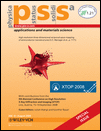Dislocation nucleation from surface step in silicon: The glide set versus the shuffle set
Corresponding Author
Julien Godet
PhyMat, UMR 6630, Université de Poitiers, CNRS, SP2MI, BP 30179, 86962 Chasseneuil, Futuroscope Cedex, France
Phone: +33 549496558, Fax: +33 549496692Search for more papers by this authorPierre Hirel
PhyMat, UMR 6630, Université de Poitiers, CNRS, SP2MI, BP 30179, 86962 Chasseneuil, Futuroscope Cedex, France
Search for more papers by this authorSandrine Brochard
PhyMat, UMR 6630, Université de Poitiers, CNRS, SP2MI, BP 30179, 86962 Chasseneuil, Futuroscope Cedex, France
Search for more papers by this authorLaurent Pizzagalli
PhyMat, UMR 6630, Université de Poitiers, CNRS, SP2MI, BP 30179, 86962 Chasseneuil, Futuroscope Cedex, France
Search for more papers by this authorCorresponding Author
Julien Godet
PhyMat, UMR 6630, Université de Poitiers, CNRS, SP2MI, BP 30179, 86962 Chasseneuil, Futuroscope Cedex, France
Phone: +33 549496558, Fax: +33 549496692Search for more papers by this authorPierre Hirel
PhyMat, UMR 6630, Université de Poitiers, CNRS, SP2MI, BP 30179, 86962 Chasseneuil, Futuroscope Cedex, France
Search for more papers by this authorSandrine Brochard
PhyMat, UMR 6630, Université de Poitiers, CNRS, SP2MI, BP 30179, 86962 Chasseneuil, Futuroscope Cedex, France
Search for more papers by this authorLaurent Pizzagalli
PhyMat, UMR 6630, Université de Poitiers, CNRS, SP2MI, BP 30179, 86962 Chasseneuil, Futuroscope Cedex, France
Search for more papers by this authorAbstract
We have studied the mechanisms of dislocation nucleation from surface defects in silicon submitted to various stresses and temperatures. Molecular dynamics simulations with three classical potentials have shown the existence of two different plastic modes in silicon which can be activated from surfaces. At high temperatures and low stresses dislocations nucleation occurs in the {111} glide set planes, while at low temperatures and large stresses it occurs in the {111} shuffle set planes. The analysis of dislocation cores and kinks shows structures like those well known in bulk silicon. This study supports the idea that plasticity in crystalline Si structures could be governed by dislocation nucleation from surfaces.
References
- 1 J. P. Hirth and J. Lothe, Theory of Dislocations, second edition ( Wiley, New York, 1982).
- 2 I. L. F. Ray and D. J. H. Cockayne, Philos. Mag. 22, 853 (1970).
- 3 J. Rabier, P. Cordier, T. Tondellier, J. L. Demenet, and H. Garem, J. Phys.: Condens. Matter 12( 49), 10059 (2000).
- 4 J. Rabier and J. L. Demenet, Scr. Mater. 45, 1259 (2001).
- 5 M. S. Duesbery and B. Joós, Philos. Mag. Lett. 74( 4), 253 (1996).
- 6 L. Pizzagalli and P. Beauchamp, Philos. Mag. Lett. 88( 6), 421 (2008).
- 7 X. J. Ning and N. Huvey, Philos. Mag. Lett. 74( 4), 241 (1996).
- 8 G. Xu, A. S. Argon, and M. Ortiz, Philos. Mag. A 75( 2), 341 (1997).
- 9 B. J. Gally and A. S. Argon, Philos. Mag. A 81( 3), 699 (2001).
- 10 A. S. Argon and B. J. Gally, Scr. Mater. 45, 1287 (2001).
- 11 S. Brochard, P. Beauchamp, and J. Grilhé, Philos. Mag. A 80( 3), 503 (2000).
- 12 P. Hirel, S. Brochard, L. Pizzagalli, and P. Beauchamp, Scr. Mater. 57, 1141 (2007).
- 13 J. Godet, S. Brochard, L. Pizzagalli, P. Beauchamp, and J. M. Soler, Phys. Rev. B 73, 092105 (2006).
- 14 S. Izumi and S. Yip, J. Appl. Phys. 104, 033513 (2008).
- 15 D. J. Chadi, Phys. Rev. Lett. 43( 1), 43 (1979).
- 16 J. Li, Modell. Simul. Mater. Sci. Eng. 11, 173 (2003).
- 17 F. H. Stillinger and T. A. Weber, Phys. Rev. B 31( 8), 5262 (1985).
- 18 J. Tersoff, Phys. Rev. B 39( 8), 5566 (1989).
- 19 M. Z. Bazant, E. Kaxiras, and J. F. Justo, Phys. Rev. B 56( 14), 8542 (1997).
- 20 J. Godet, S. Brochard, L. Pizzagalli, and P. Beauchamp, Phys. Rev. B 70( 5), 54109 (2004).
- 21 L. Pizzagalli, A. Pedersen, A. Arnaldsson, H. Jónsson, and P. Beauchamp, Phys. Rev. B 77, 064106 (2008).
- 22 H. Koizumi, Y. Kamimura, and T. Suzuki, Philos. Mag. A 80( 3), 609 (2000).
- 23 L. Pizzagalli, P. Beauchamp, and J. Rabier, Philos. Mag. 83( 10), 1191 (2003).
- 24 M. S. Duesbery, B. Joos, and D. J. Michel, Phys. Rev. B 43( 6), 5143 (1991).
- 25 R. W. Nunes, J. Bennetto, and D. Vanderbilt, Phys. Rev. B 57, 10388 (1998).
- 26 J. Bennetto, R. W. Nunes, and D. Vanderbilt, Phys. Rev. Lett. 79( 2), 245 (1997).
- 27 J. R. K. Bigger, D. A. McInnes, A. P. Sutton, M. C. Payne, I. Stich, R. D. King-Smith, D. M. Bird, and L. J. Clarke, Phys. Rev. Lett. 69( 15), 2224 (1992).
- 28 V. V. Bulatov, J. F. Justo, W. Cai, S. Yip, A. S. Argon, T. Lenosky, M. de Koning, and T. D. de la Rubia, Philos. Mag. A 81( 5), 1257 (2001).
- 29 J. Godet, L. Pizzagalli, S. Brochard, and P. Beauchamp, Comput. Mater. Sci. 30( 1–2), 16 (2004).
- 30 S. Goedecker, T. Deutsch, and L. Billard, Phys. Rev. Lett. 88( 23), 235501 (2002).
- 31 M. Heggie and R. Jones, Philos. Mag. B 48( 4), 365 (1983).
- 32 A. Valladares and A. P. Sutton, J. Phys.: Condens. Matter 18, 3735 (2006).
- 33 A. Moulin, M. Condat, and L. P. Kubin, Philos. Mag. A 79( 8), 1995 (1999).
- 34 M. D. Uchic, D. M. Dimiduk, J. N. Florando, and W. D. Nix, Science 305, 986 (2004).
- 35 T. Kizuka, Y. Takatani, K. Asaka, and R. Yoshizaki, Phys. Rev. B 72, 035333 (2005).
- 36 K. C. Lu, W. W. Wu, H. W. Wu, C. M. Tanner, J. P. Chang, L. J. Chen, and K. N. Tu, Nano Lett. 7( 8), 2389 (2007).
- 37 A. S. B. S. G. Roberts and P. B. Hirsch, Mater. Sci. Eng. A 176, 91 (1994).
- 38 J. Rabier, P. Cordier, J. L. Demenet, and H. Garem, Mater. Sci. Eng. A 309–310, 74 (2001).




